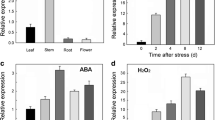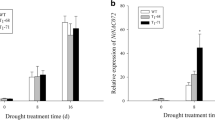Abstract
High salt restricts the growth and development of plants. A diverse range of genes are involved in the response to salt stress. Here we report that MdCAIP1 (C2-domain ABA Insensitive Protein1), a single C2-domain containing protein, has a conserved structure consisting of an eight-stranded anti-parallel β-sandwich. MdCAIP1 was able to bind to phospholipids in a Ca2+-dependent manner and localized to the plasma membrane. qRT-PCR analysis showed that MdCAIP1 was induced by abiotic stresses including salt, osmotic, and drought stress, as well as the hormone JA. Transgenic apple calli and Arabidopsis over-expressing MdCAIP1 were more tolerant to salt and osmotic stress, and had higher proline content and lower MDA content under these stressful conditions. Furthermore, MdCAIP1 could homodimerize. These results indicate that MdCAIP1 is a Ca2+-dependent phospholipid-binding protein, and implicate it in tolerance to salt and osmotic stress.
Key message
MdCAIP1, a Ca2+-dependent phospholipid-binding protein, could homodimerize and positively regulated salt and osmotic tolerance in plants.






Similar content being viewed by others
Abbreviations
- ABA:
-
Abscisic acid
- MS:
-
Murashige and Skoog
- MDA:
-
Malondialdehyde
- qRT-PCR:
-
Quantitative reverse transcription-PCR
- Y2H:
-
Yeast two-hybrid
- JA:
-
Jasmonic acid
- SA:
-
Salicylic acid
- ACC:
-
1-Aminocyclopropanecarboxylic acid
- VC:
-
Vector control
- ET:
-
Ethylene
References
An XH, Tian Y, Chen KQ, Wang XF, Hao YJ (2012) The apple WD40 protein MdTTG1 interacts with bHLHbut not MYB proteins to regulate anthocyanin accumulation. J Plant Physiol 169:710–717
Batistič O, Waadt R, Steinhorst L, Held K, Kudla J (2010) CBL-mediated targeting of CIPKs facilitates the decoding of calcium signals emanating from distinct cellular stores. Plant J 61:211–222
Bittova L, Sumandea M, Cho W (1999) Astructure-function study of the C2 domain of cytosolic phospholipase A2: identification of essential calcium ligands and hydrophobic membrane binding residues. J Biol Chem 274:9665–9672
Boudsocq M, Sheen J (2013) CDPKs in immune and stress signaling. Trends Plant Sci 18:30–40
Chapman ER, An S, Edwardson JM, Jahn R (1996) A novel function for the second C2 domain of synaptotagmin. Ca2+-triggered dimerization. J Biol Chem 271:5844–5849
Cho W, Stahelin RV (2006) Membrane binding and subcellular targeting of C2 domains. Biochim Biophys Acta 1761:838–849
Cho KM, Nguyen HTK, Kim SY, Shin JS, Cho DH, Hong SB, Shin JS, Ok SH (2016) CML10, a variant of calmodulin, modulates ascorbic acid synthesis. New Phytol 209:664–678
Corbalan-Garcia S, Gómez-Fernández JC (2014) Signaling through C2 domains: more than one lipid target. BBA-Biomembranes 1838:1536–1547
Crabb BS, Studdert MJ (1995) Expression of small regions of equine herpesvirus 1 glycoprotein C in Escherichia coli. Vet Microbiol 46:181–191
Demiral T, Türkan I (2005) Comparative lipid peroxidation, antioxidant defense systems and proline content in roots of two rice cultivars differing in salt tolerance. Environ Exp Bot 53:247–257
Diaz M, Sanchez-Barrena MJ, Gonzalez-Rubio JM, Rodriguez L, Fernandez D, Antoni R, Yunta C, Belda-Palazon B, Gonzalez-Guzman M, Peirats-Llobet M, Menendez M, Boskovic J, Marquezc JA, Rodriguez PL, Albert A (2016) Calcium-dependent oligomerization of CAR proteins at cell membrane modulates ABA signaling. Proc Natl Acad Sci USA 113:E396–E405
Du W, Lin H, Chen S, Wu Y, Zhang J, Fuglsang AT, Palmgren MG, Wu W, Guo Y (2011) Phosphorylation of SOS3-like calcium-binding proteins by their interacting SOS2-like protein kinases is a common regulatory mechanism in Arabidopsis. Plant Physiol 156:2235–2243
Dubrovina AS, Kiselev KV, Khristenko VS, Aleynova OA (2016) VaCPK21, a calcium-dependent protein kinase gene of wild grapevine Vitis amurensis Rupr., is involved in grape response to salt stress. Plant Cell Tiss Org 124:137–150
Farah CA, Sossin WS (2012) The role of C2 domains in PKC signaling. Calcium signaling. Springer, Dordrecht, pp 663–683
Gallagher CM, Knoblich JA (2006) The conserved C2 domain protein lethal (2) giant discs regulates protein trafficking in Drosophila. Dev Cell 11:641–653
Guerrero-Valero M, Ferrer-Orta C, Querol-Audí J, Marin-Vicente C, Fita I, Gómez-Fernández JC, Verdaguer N, Corbalán-García S (2009) Structural and mechanistic insights into the association of PKCα-C2 domain to PtdIns(4,5)P2. Proc Natl Acad Sci USA 106:6603–6607
Guillén J, Ferrer-Orta C, Buxaderas M, Pérez-Sánchez D, Guerrero-Valero M, Luengo-Gil G, Pous J, Guerra P, Gómez-Fernández JC, Verdaguer N, Corbalán-García S (2013) Structural insights into the Ca2+ and PI(4,5)P2 binding modes of the C2 domains of rabphilin 3A and synaptotagmin 1. Proc Natl Acad Sci USA 110:20503–20508
Han C, Gu Y, Shan H, Mi W, Sun J, Shi M, Zhang X, Lu X, Han F, Gong Q, Yu W (2017) O-GlcNAcylation of SIRT1 enhances its deacetylase activity and promotes cytoprotection under stress. Nat Commun 8:1491
Kang CH, Moon BC, Park HC, Koo SC, Chi YH, Cheong YH, Yoon B, Lee SY, Kim CY (2013) Rice small C2-domain proteins are phosphorylated by calcium-dependent protein kinase. Mol Cells 35:381–387
Kim CY, Koo YD, Jin JB, Moon BC, Kang CH, Kim ST, Park BO, Lee SY, Kim ML, Hwang I, Kang KY, Bahk JD, Lee SY, Cho MJ (2003) Rice C2-domain proteins are induced and translocated to the plasma membrane in response to a fungal elicitor. Biochemistry 42:11625–11633
Kim YC, Kim SY, Choi D, Ryu CM, Park JM (2008) Molecular characterization of a pepper C2 domain-containing SRC2 protein implicated in resistance against host and non-host pathogens and abiotic stresses. Planta 227:1169–1179
Kudla J, Batistič O, Hashimoto K (2010) Calcium signals: the lead currency of plant information processing. Plant Cell 22:541–563
Liu J, Zhu JK (1998) A calcium sensor homolog required for plant salt tolerance. Science 280:1943–1945
Liu XJ, Liu X, An XH, Han PL, You CX, Hao YJ (2017) An apple protein kinase MdSnRK1.1 interacts with MdCAIP1 to regulate ABA sensitivity. Plant Cell Physiol 58:1631–1641
Lokdarshi A, Conner WC, McClintock C, Li T, Roberts D (2015) Arabidopsis CML38, a calcium sensor that localizes to ribonucleoprotein complexes under hypoxia stress. Plant Physiol 170:1046–1059
Murray D, Honig B (2002) Electrostatic control of the membrane targeting of C2 domains. Mol Cell 9:145–154
Nalefski EA, Falke JJ (1996) The C2 domain calcium-binding motif: structural and functional diversity. Protein Sci 5:2375–2390
Ormancey M, Thuleau P, Mazars C, Cotelle V (2017) CDPKs and 14-3-3 proteins: emerging duo in signaling. Trends Plant Sci 22:263–272
Ouelhadj A, Kuschk P, Humbeck K (2006) Heavy metal stress and leaf senescence induce the barley gene HvC2d1 encoding a calcium-dependent novel C2 domain-like protein. New Phytol 170:261–273
Quan R, Wang J, Yang D, Zhang H, Zhang Z, Huang R (2017) EIN3 and SOS2 synergistically modulate plant salt tolerance. Sci Rep 7:44637
Rizo J, Südhof TC (1998) C2-domains, structure and function of a universal Ca2+-binding domain. J Biol Chem 273:15879–15882
Rodriguez L, Gonzalez-Guzman M, Diaz M, Rodrigues A, Izquierdo-Garcia AC, Peirats-Llobet M, Fernandez MA, Antoni R, Fernandez D, Marquez JA, Mulet JM, Albert A, Rodrigueza PL (2014) C2-domain abscisic acid-related proteins mediate the interaction of PYR/PYL/RCAR abscisic acid receptors with the plasma membrane and regulate abscisic acid sensitivity in Arabidopsis. Plant Cell 26:4802–4820
Song H, Wang P, Hou L, Zhao S, Zhao C, Xia H, Li P, Zhang Y, Bian X, Wang X (2016) Global analysis of WRKY genes and their response to dehydration and salt stress in soybean. Front Plant Sci 7:9
Sutton RB, Davletov BA, Berghuis AM, Sudhof TC, Sprang SR (1995) Structure of the first C2 domain of synaptotagmin I: a novel Ca2+/phospholipid-binding fold. Cell 80:929–938
Udawat P, Jha RK, Sinha D, Mishra A, Jha B (2016) Overexpression of a cytosolic abiotic stress responsive universal stress protein (SbUSP) mitigates salt and osmotic stress in transgenic tobacco plants. Front Plant Sci 7:518
Verdaguer N, Corbalan-Garcia S, Ochoa WF, Fita I, Gómez-Fernández JC (1999) Ca2+ bridges the C2 membrane-binding domain of protein kinase Cα directly to phosphatidylserine. EMBO J 18:6329–6338
Wang XY, Li Q, Niu XW, Chen HY, Xu LL, Qi C (2009) Characterization of a canola C2 domain gene that interacts with PG, an effector of the necrotrophic fungus Sclerotinia sclerotiorum. J Exp Bot 60:2613–2620
Yang H, Li Y, Hua J (2006) The C2 domain protein BAP1 negatively regulates defense responses in Arabidopsis. Plant J 48:238–248
Yang WQ, Lai Y, Li MN, Xu WY, Xue YB (2008) A novel C2-domain phospholipid-binding protein, OsPBP1, is required for pollen fertility in rice. Mol Plant 1:770–785
Yokotani N, Ichikawa T, Kondou Y, Maeda S, Iwabuchi M, Mori M, Hirochika H, Matsui M, Oda K (2009) Overexpression of a rice gene encoding a small C2 domain protein OsSMCP1 increases tolerance to abiotic and biotic stresses in transgenic Arabidopsis. Plant Mol Biol 71:391–402
Zhang G, Sun YF, Li YM, Dong YL, Huang XL, Yu YT, Wang JM, Wang XM, Wang XJ, Kang ZS (2013) Characterization of a wheat C2 domain protein encoding gene regulated by stripe rust and abiotic stresses. Biol Plant 57:701–710
Zhou S, Jia L, Chu H, Wu D, Peng X, Liu X, Zhang J, Zhao J, Chen K, Zhao L (2016) Arabidopsis CaM1 and CaM4 promote nitric oxide production and salt resistance by inhibiting S-nitrosoglutathione reductase via direct binding. PLoS Genet 12:e1006255
Acknowledgements
This work was supported by grants from National Natural Science Foundation of China (31430074, U1706202), the Ministry of Agriculture of China (CARS-28), Shandong Province (SDAIT-06-03), and the Ministry of Education of China (IRT15R42).
Author information
Authors and Affiliations
Contributions
Y.J.H. planned and designed the research. X.J.L., Y.H.D. and X.L. performed experiments and analyzed the data. X.J.L., C.X.Y. and Y.J.H. wrote the manuscript.
Corresponding author
Ethics declarations
Conflict of interest
The authors have no conflicts of interest to declare.
Additional information
Communicated by Konstantin V. Kiselev.
Publisher’s Note
Springer Nature remains neutral with regard to jurisdictional claims in published maps and institutional affiliations.
Electronic supplementary material
Below is the link to the electronic supplementary material.
11240_2019_1600_MOESM1_ESM.doc
Supplementary material 1 (DOC 3519 kb) Figure. S1 qRT-PCR analysis of the expression level of MdCAIP1 in MdCAIP1 transgenic calli (A) and Arabidopsis (B). Figure. S2 The PAL (A), PPO (B) and PO (C) activtities in MdCAIP1 transgenic calli and wild tpye.
Rights and permissions
About this article
Cite this article
Liu, XJ., Dong, YH., Liu, X. et al. A C2-domain phospholipid-binding protein MdCAIP1 positively regulates salt and osmotic stress tolerance in apple. Plant Cell Tiss Organ Cult 138, 29–39 (2019). https://doi.org/10.1007/s11240-019-01600-y
Received:
Accepted:
Published:
Issue Date:
DOI: https://doi.org/10.1007/s11240-019-01600-y




